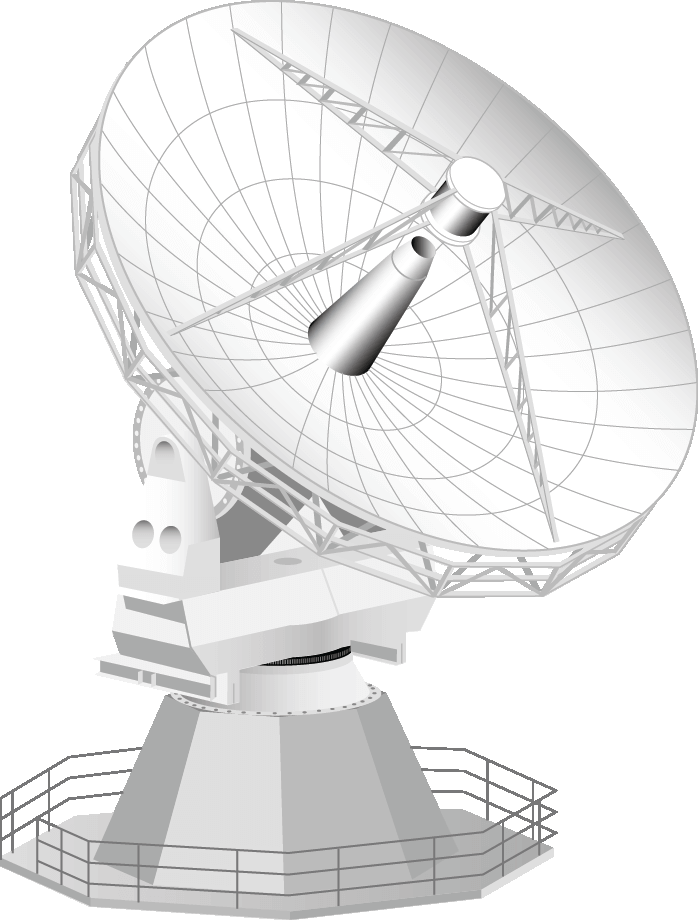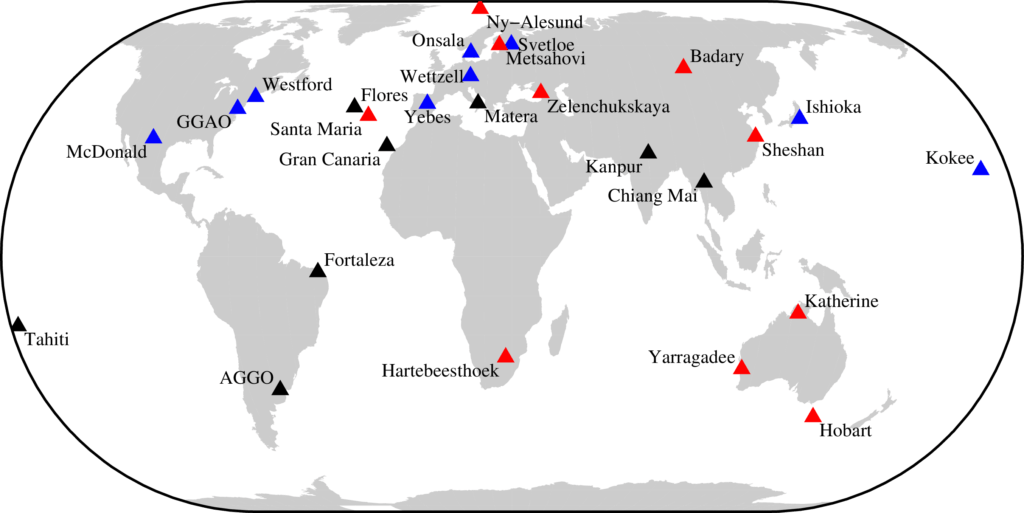IVS – International VLBI Service for Geodesy and Astrometry
Development
The International VLBI Service for Geodesy and Astrometry (IVS) is an international collaboration of organizations that operate or support Very Long Baseline Interferometry (VLBI) components. IVS was established in 1999 and became a service of IAG that year. In 2000, IVS was recognized as a service of the International Astronomical Union (IAU). In 2002, IVS became a member of the Federation of Astronomical and Geophysical Data Analysis Services (FAGS). Following the dissolution of the FAGS federation at the end of 2008, IVS applied for membership in the newly established World Data System (WDS) and was approved in 2011. IVS interacts closely with the International Earth Rotation and Reference Systems Service (IERS), which is tasked by IAU and IUGG with maintaining the international celestial and terrestrial reference frames (ICRF and ITRF).
Mission and Objectives
The objectives of IVS are:
• To provide a service to support geodetic, geophysical, and astrometric research and operational activities.
• To promote research and development activities in all aspects of the geodetic and astrometric VLBI technique.
• To interact with the community of users of VLBI products and to integrate VLBI into a global Earth observing system.
To meet these objectives, IVS coordinates VLBI observing programs, sets performance standards for VLBI stations, establishes conventions for VLBI data formats and data products, issues recommendations for VLBI data analysis software, sets standards for VLBI analysis documentation, and institutes appropriate VLBI product delivery methods to ensure suitable product quality and timeliness. IVS closely coordinates its activities with the astronomical community because of the dual use of many VLBI facilities and technologies for both astronomy and geodesy/astrometry.
see also: https://ivscc.gsfc.nasa.gov/about/index.html
Products
VLBI data products currently available:
• Full set of Earth orientation parameters (polar motion, UT1−UTC, nutation)
• Terrestrial reference frame
• Celestial reference frame
• Tropospheric parameters
• Time series of baseline lengths
All VLBI data products are archived in IVS Data Centers and are publicly available.
see also: https://ivscc.gsfc.nasa.gov/products-data/index.html
Structure, Members, and Directing Board
IVS accomplishes its goals through Permanent Components. As of 2020 the IVS has:
• 34 Network Stations, acquiring high performance VLBI data
• 3 Operation Centers, coordinating activities of Network Stations
• 7 Correlators, processing acquired data, providing feedback to stations and providing processed data to analysts
• 5 Data Centers, distributing products to users, providing storage and archiving functions
• 31 Analysis Centers, analyzing the data and producing results and products
• 7 Technology Development Centers, developing new VLBI technology
• 1 Coordinating Center, coordinating daily and long-term activities of IVS
All together there are 88 Permanent Components, representing 41 organizations in 21 countries, and about 320 individuals who are Associate Members. The 41 organizations that support IVS components are IVS Member Organizations. There are also 6 Affiliated Organizations that cooperate with IVS on issues of common interest but do not support an IVS component.
In addition, the IVS Directing Board determines policies, standards, and goals.
see also: https://ivscc.gsfc.nasa.gov/about/org/components/index.html
Publications and Meetings
IVS publishes a Biennial Report, a thrice-annual Newsletter, and Proceedings from its bi-annual General Meeting. All publications are available from the Coordinating Center and also published on the website. IVS holds a General Meeting every two years, a Technical Operations Workshop every two years, an Analysis Workshop every year, and a VLBI School for students and novices every three years.
see also: https://ivscc.gsfc.nasa.gov/publications/index.html and https://ivscc.gsfc.nasa.gov/meetings/index.html
VGOS: The New VLBI Component of GGOS
In order to meet the very stringent science requirements established by GGOS, such as an accuracy of 1 mm in station position and 0.1 mm/year in station velocity on global scales, the four space-geodetic techniques are developing next-generation versions of their techniques. In the VLBI case, the original system was conceived and constructed in the 1960s and 1970s. Hence, aging antennas, increasing radio frequency interference (RFI) problems, obsolete electronics, and high operating costs were further drivers to upgrade the VLBI system to meet the required level of accuracy, reliability, and timeliness. The IVS contribution to GGOS is the VLBI Global Observing System (VGOS). The VGOS system is based on the so-called broadband delay, which uses four (or more) frequency bands in the range from 2.5 GHz to 14 GHz. The observations are taken by fast-slewing, 12-m class antennas at a high data rate of 8 Gbps and above. The implied higher sampling of the sky, as compared to the legacy system, will reduce the impact of error components. Together with a reduction of systematic errors, this will result in an anticipated overall accuracy of 1 mm. VGOS is planned to replace the currently employed two-band VLBI system (legacy S/X system) as its operational system for product creation over the next few years.
In the recent past, the IVS has made strides to implement the new broadband system globally. A modernized station infrastructure is being established worldwide and in 2020 a fledgling network of 8–10 VGOS stations started observing in operational IVS sessions. It is anticipated that the global network will grow to 25 stations and beyond in the coming years. As part of the modernization process, other infrastructure components of the VLBI processing chain have been further developed as well, including the VGOS correlation and post-processing capabilities as well as VGOS data analysis.
Artist’s rendition of a fast-slewing, 12-m class VGOS antenna.
Projected VGOS network in the early 2020s.
Artist’s rendition of a fast-slewing, 12-m class VGOS antenna.
Projected VGOS network in the early 2020s (Status: Sept 2020).





